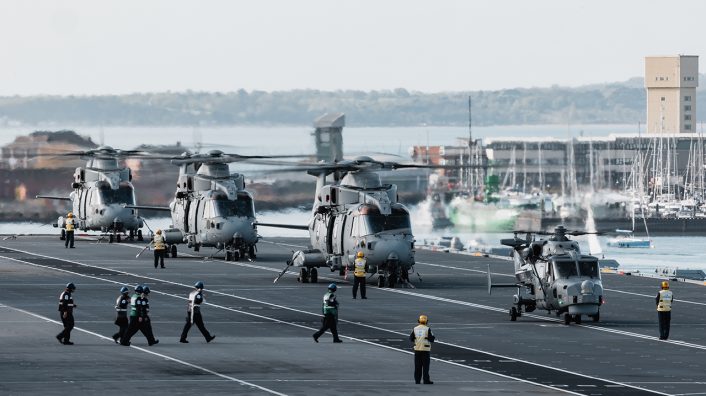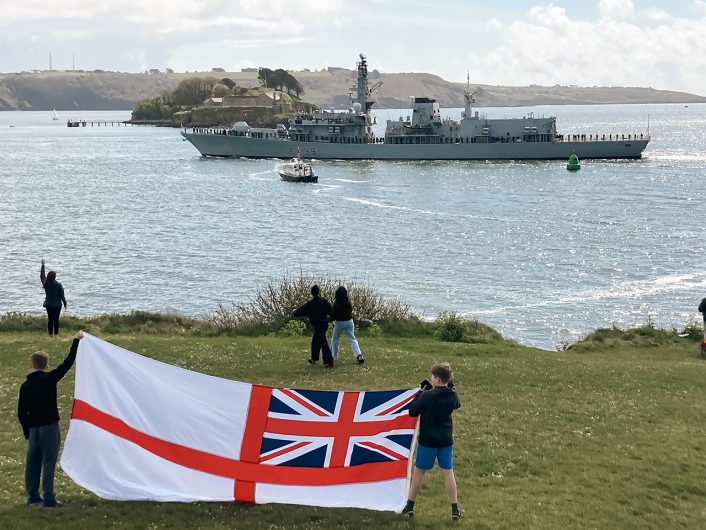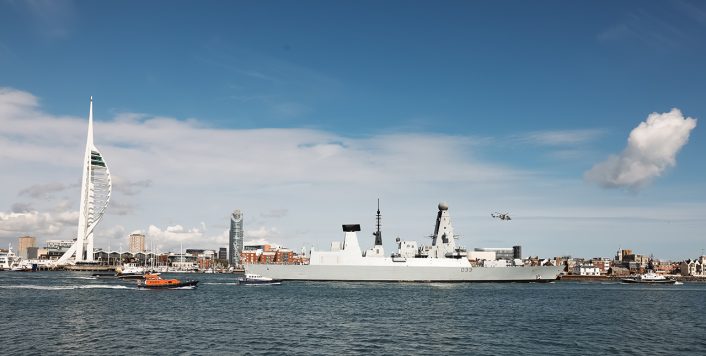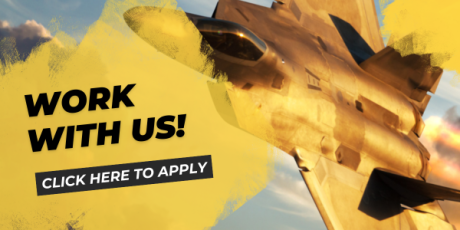The highly awaited Carrier Strike Group 25 deployment started on Apr. 22, taking HMS Prince of Wales, its F-35B-focused air wing and an escort force to the Indo-Pacific.
Many years in the making, Operation Highmast, the official operational title for the Carrier Strike Group 25 (CSG 25) deployment, is the first major Royal Navy deployment to the Indo-Pacific since 2021’s Operation Fortis. This time, all F-35B Lightning IIs sailing with the strike group will be UK owned and operated, with personnel from both 617 Squadron and 809 Naval Air Squadron (NAS) embarked.
According to Navy Lookout, 18 F-35Bs will make up the initial detachment with an increase to 24 planned for later in the deployment. Previous Queen Elizabeth class deployments have seen a maximum of only eight UK jets embarked, making this the largest deployed UK carrier air wing in decades.

Supplementing the F-35B will be the Royal Navy’s Merlin and Wildcat helicopters. Merlin HM2s from RNAS Culdrose will provide a highly capable anti-submarine warfare function, and those equipped with the Crowsnest system will comprise the carrier’s airborne early warning (AEW) force. RNAS Yeovilton’s Merlin HC4 helicopters will be on hand to fly general utility and logistics taskings, while Wildcat HMA2s will operate with Martlet and Sea Venom missiles to help protect the task force from hostile attack.
For the first time, unmanned aerial vehicles (UAV) will deploy with HMS Prince of Wales in a logistics role. 700X NAS are due to embark with nine Malloy T-150 drones, which will be able to transfer light payloads between ships without the use of a helicopter or replenishment at sea (RAS) rig. They will also fly the RQ-20 Puma fixed wing UAV in an intelligence, surveillance, and reconnaissance (ISR) capacity.
Global Deployment
HMS Prince of Wales will lead the CSG to locations as distant as Japan and Australia, working with allied forces along the journey. According to current plans, the CSG will take part in Exercise Talisman Sabre in July. Usually a U.S.-Australia exercise, the British CSG’s participation would be a strong signal of the UK’s commitment to the AUKUS partnership.
This will all come after an initial work-up period where the remaining parts of the air wing will be embarked, the escort group comes together, and crews are given the opportunity to settle in and practice their skills before heading to areas where inbound threats may well be the real deal.
There is a possibility that, as with the 2021 deployment, combat operations will be launched as the carrier sails through the Middle East region. In 2021, the target was Daesh in Iraq and Syria – this time it is likely to be Houthi rebels in Yemen. Royal Air Force Typhoons from RAF Akrotiri have taken part in a number of airstrikes, but are constrained by numbers and distance. The co-located Voyager tanker force has, though, aided ongoing U.S. Navy operations with refueling support.
First images from the UK of its attack against Iran-backed Houthi rebels in Yemen.
Four Typhoon jets – supported by a Voyager refuelling aircraft – dropped Paveway bombs on 2 military facilities used by Houthis to launch drone and missile strikes pic.twitter.com/Ynhh3hdIIN
— Deborah Haynes (@haynesdeborah) January 12, 2024
UK Secretary of State for Defence John Healey noted “This is a unique opportunity for the UK to operate in close coordination with our partners and allies in a deployment that not only shows our commitment to security and stability.”
“As one of only a few nations capable of leading a deployment of this scale, the Royal Navy is once again demonstrating that UK defence is strong, modern, and ready to meet the threats of today and tomorrow.”
He further added that trade and exports are also a focus of the deployment, exercising the immense soft power potential of a 65,000 tons warship that acts not only as a floating airbase, but also as a floating embassy.
Commodore James Blackmore, Commander UK Carrier Strike Group, says Operation Highmast “will demonstrate credible deterrence and our support to NATO and the rules-based international order.”
Escorting the Carrier
Approximately 2,500 personnel will sail with the strike group, increasing as high as 4,500 during major exercises that are scheduled during parts of the journey. 2,100 of these personnel are British, while the remainder are split between the ships of Norway, Canada, and Spain that are joining the deployment.

Although the protection of a high value asset like an aircraft carrier is always an important consideration, the journey taken by CSG 25 through the Red Sea, Indian Ocean, and into the South China Sea will require exceptional capabilities across all domains. The Red Sea will put into focus the carrier group’s air defenses, being a high risk area for one-way attack UAVs, cruise missiles, and even ballistic missiles, launched by Houthi rebels in Yemen.
Meanwhile, as the group approaches China’s area of interest it is sure to draw attention from People’s Liberation Army Navy surface vessels, submarines, and a variety of Chinese military aircraft. Anti-submarine warfare specialist units will be tested as they attempt to screen and sanitize an area for the carrier group to operate, while navigators on the bridge face the prospect of trying to plan routes to keep a safe distance from ships attempting to gather intelligence.
HMS Prince of Wales will be supported in these tasks by a heavily mixed group of surface and sub-surface escorts. First of all, on Monday Apr. 21, an Astute class nuclear powered attack submarine (SSN), likely HMS Astute (S119) itself, departed HMNB Devonport. The UK Ministry of Defence does not routinely make official comments on the activities of its submarines, so we can only make the assumption, based on noted activities, that this submarine will deploy with the strike group.
HMS Astute outbound Devonport a few moments ago pic.twitter.com/l3vy6Vq2Zb
— Wrightys Warships (@AllanWarships) April 21, 2025
Fending off submarines of other nations will be the Royal Navy’s battle-proven Type 23 frigate HMS Richmond (F239), working in tandem with an embarked Merlin HM2 of 814 NAS. The Type 23, also known as Duke class, is in the twilight of its active years, with several already having been retired early due to fatigue, but thanks to upgrade programs the ship remains one of the world’s premier ASW specialist warships and additionally boasts the capable Sea Ceptor point-defense missile system.
Notably, Richmond is one of the handful of Type 23 frigates outfitted with the new Naval Strike Missile and has additionally received a modernized Link 16 tactical datalink upgrade that facilitates the routing of information via satellites.

Richmond sailed from Devonport on Apr. 22 alongside the Canadian Halifax class frigate HMCS Ville de Québec (FFH 332). The Halifax class is of a similar vintage to the Type 23, and similarly will be replaced in the years to come by the Type 26 (referred to as the River class destroyer by Canada).
Ville de Québec is carrying a CH-148 Cyclone maritime helicopter and is outfitted with Evolved Sea Sparrow Missiles for air defense, Harpoon anti-ship missiles, a Phalanx close-in weapons system (CIWS), and 57 mm naval gun.
🇨🇦HMCS Ville de Québec @RoyalCanNavy sailing from Devonport this afternoon for #CSG25 deployment.
Via @Rockhoppas pic.twitter.com/6bAjEw539f
— Navy Lookout (@NavyLookout) April 22, 2025
Type 45 destroyer HMS Dauntless (D33), fresh from taking part in exercises testing the ship and crew’s ability to defend against fast-moving drone attacks, will lead the area air defense mission using its Aster 15 and Aster 30 missiles coupled to the SAMPSON multi-function radar and S1850M long range search radar. This system, as implemented on the Type 45, is referred to as Sea Viper, and it proved itself in combat extensively in the Red Sea during the course of 2024 downing drones and a ballistic missile.
One of the Wildcat HMA2 helicopters will embark on Dauntless for the deployment, together forming a formidable protective capability.

The Spanish AEGIS-equipped air defense frigate ESPS Méndez Núñez (F-104) is scheduled to join the strike group as it approaches the Mediterranean Sea. This ship sports 48 Mark 41 vertical launch system (VLS) cells, able to carry RIM-66 SM-2MR medium range anti-air missiles and quad packed ESSMs.
HNoMS Roald Amundsen (F311), a Fridtjof Nansen class frigate of the Royal Norwegian Navy, completes the tally of combat vessels. Roald Amundsen departed Bergen on the same day HMS Prince of Wales set sail, so will likely rendezvous with the group over the coming days. It is equipped with VLS cells for ESSM, alongside launchers for the Naval Strike Missile, and a 76 mm OTO Melara Super Rapid main gun. A detachment of Royal Navy personnel will embark with the Norwegian crew in order to operate a Wildcat helicopter from the ship’s hangar and flight deck.

Logistics & Air Support
Just as important to the task force’s success are the accompanying logistics vessels RFA Tidespring (A136) and HNoMS Maud (A530). As we explained in a prior article, Maud takes the place of the Royal Fleet Auxiliary’s dedicated solid stores ship which will not deploy on CSG 25.
Tidespring and Maud will supply fuel to all ships in the group, and although they are not dedicated solid stores ships, they will be able to transport a sizable array of supplies that can then be transferred by helicopter or drone. Already at sea on Apr. 22, Tidespring embarked a Merlin HM2 from 814 NAS as the ship sailed south of their base in Cornwall.
@RFATidespring -Today TSPG is Embarking 814 Merlin MK2, before carrying out internal drills @RFAHeadquarters @RNASCuldrose @HMSPWLS #CSG25 #TuesdayMotivaton #flynavy pic.twitter.com/AFfyzUtfdY
— RFA Tidespring (@RFATidespring) April 22, 2025
RFA Argus, a multirole casualty receiving and aviation training ship that has been upgraded to act as an interim littoral strike ship, is due to join the CSG in the latter stages of the deployment following the completion of refit work. Argus was commissioned into the RFA in 1988 but has actually served since 1982, when the ship, then named MV Commander Bezant, was requisitioned for use during the Falklands War. It is expected to serve into the 2030s.
While these ships will be able to make use of the plethora of allied ports along the journey to stop by and collect supplies, many of these supplies will themselves need to be transported to and from the ports by air. Spare parts, mail, and even crew members themselves, will be conveyed by a sustained Royal Air Force operation using Voyagers, A400M Atlas C1s, and C-17A Globemaster IIIs.
During 2021’s Operation Fortis, the RAF’s Voyager force alone flew 220 hours, transported 1700 people, and delivered 180 tonnes of fuel through its refueling hoses. It is also possible that RAF P-8A Poseidon MRA1s will deploy to strategic positions at certain phases of the deployment to lend an extra hand monitoring surface and sub-surface threats.
The Aviationist will continue to report on CSG 25 as it progresses through the deployment, which is sure to generate many interesting stories, images, and videos.









